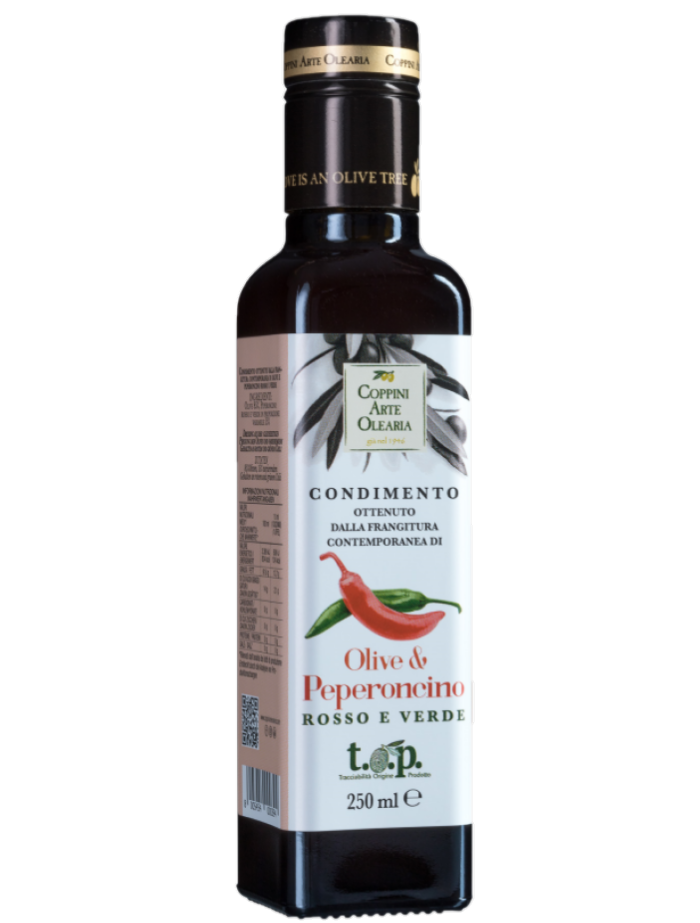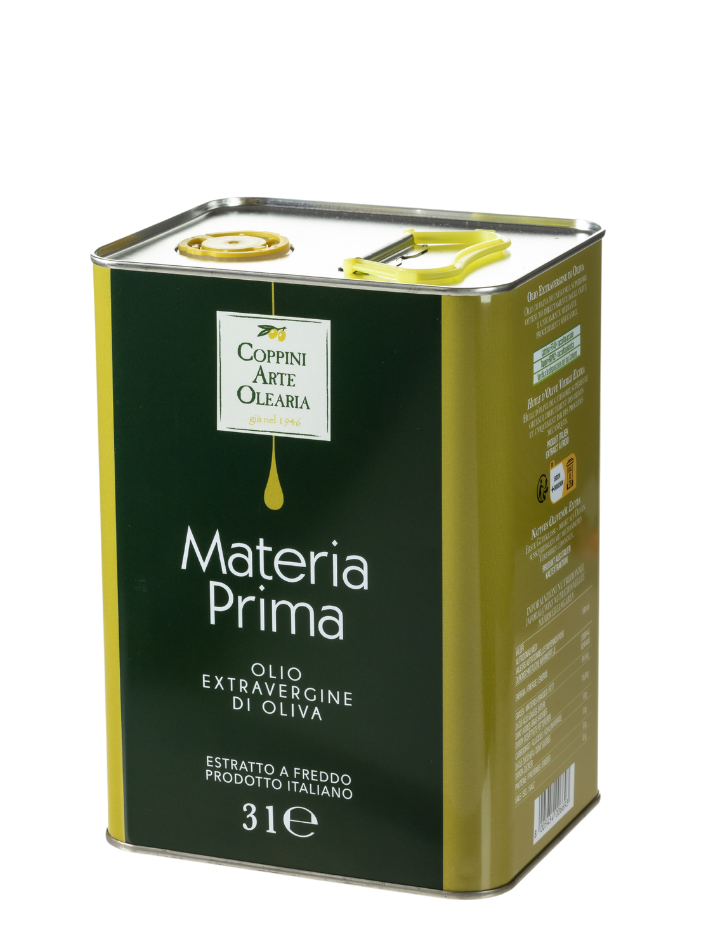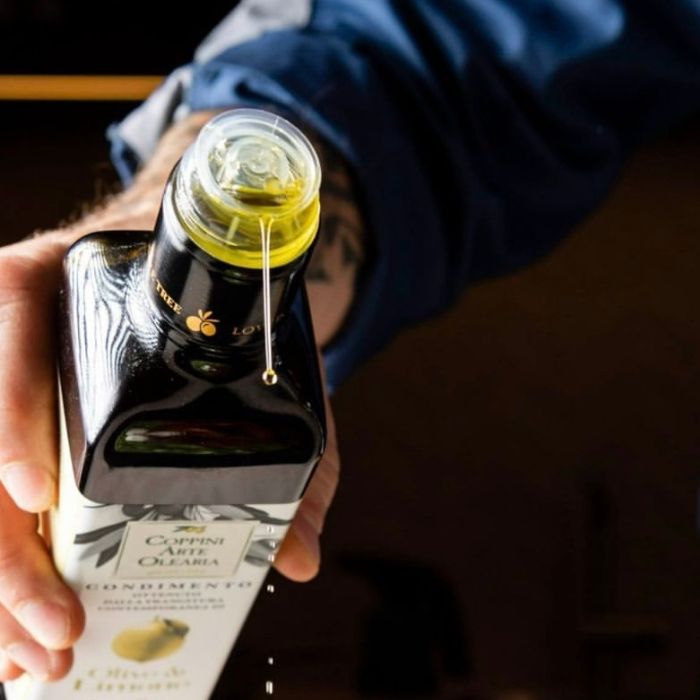
B
Beating : harvesting olives using poles to hit the branches to make the olives fall.
Organic : oil produced without the use of chemical fertilizers, pesticides, herbicides and petroleum derivatives.
Blend : oil produced with a mixture of different cultivars.
Picking : harvesting of olives carried out manually with the help of tools (rakes or combs) that do not cause damage to the fruit and do not break the fibres of the olive branches.
C
Cultivar : the "variety" of olives from which oil is obtained. In Italy we have about 300 cultivars, some typical of certain territories.
D
Decanter : the centrifugal extractor, which is based on the physical principle that by centrifuging several elements of different specific weight, they separate. It is therefore used to separate the oil from the vegetation water and the pomace.
Demucilagination : in the oil refining process, elimination of mucilage, resins and impurities from the oil.
Deodorization : in the oil refining process, removal of aldehydes or ketones, responsible for the unpleasant odors of low-quality oil.
Demargarination : in the oil refining process, elimination of saturated glycerides that make the oil cloudy.
Deacidification : in the oil refining process, an operation to correct the excessive acidity of low-quality oil.
Drupe : the olive is a drupe, that is, a small fleshy fruit that, when ripe, does not open spontaneously to release the seed. It has a thin skin, a fleshy central part and a woody stone that contains the seed inside.
AND
Endocarp : is the stone of the olive, that is, the woody casing that contains the seed.
Epicarp: the skin of the olive, of modest thickness, which protects the fruit. Green in color, it becomes reddish or brown until it becomes black as it ripens.
Cold extraction : wording sometimes placed on the labels of bottles of virgin or extra virgin olive oil , which certifies that the oil has been produced through a mechanical process, at a temperature below 27°C with a process that safeguards the organoleptic properties of the olives. The temperature of 27°C was established by a community law.
Hot extraction : The hot mill involves the application of heat points during the crushing process. Heat improves the yield of the olives, but the quality of the product is lower, as heat modifies the organoleptic properties of the olives.
Extra virgin : oil obtained by mechanical pressing, without any mechanical or chemical treatment, with a maximum acidity of 0.8 g per 100 g
F
Fiscolo : container in which the olive paste is placed before pressing.
Oil mill: a plant for crushing olives and squeezing their oil.
Crushing : process of crushing olives in the mill.
Cold pressing: see Cold extraction.
Fruity: refers to the flavor and aroma of oil that recalls the smell and taste of healthy fruit, picked at the right time. When tasting, you can distinguish an intense fruitiness, which can also cause burning in the last part of the oral cavity, from a medium or delicate fruitiness, less pungent.
G
Gentle : said of an oil with a sweet and pleasant flavour, lacking the bitter, astringent and spicy attributes.
Kneading : operation following crushing, done to break the emulsion between water and oil.
H
HDL : This acronym identifies "good" cholesterol. Olive oil is a fat composed mainly of oleic acid, capable of protecting HDL at the expense of cholesterol that is harmful to the body (LDL).
THE
ICEA : Institute for the Certification of Food Products.
Veraison : phase of olive ripening in which they change colour, from intense green to the final colour which depends on the type of cultivar.
THE
Lampante : olive oil used in the past to fuel oil lamps. It is a virgin olive oil whose free acidity, expressed as oleic acid, is greater than 2.00 g per 100 g. It is still an edible oil, although of low quality.
M
Mesocarp : the pulp of the olives, of variable thickness which represents 70.80% of the weight of the fruit.
Mill: wheeled machine, part of the mill, with which the olives are crushed.
Monocultivar : refers to oil produced with a single olive cultivar .
Milling : crushing of the olives done in mills (or grinders) or in crushers with which the olive paste is obtained from which the oil will be extracted.
Morchia : oil residue formed by the aggregation of olive particles that over time tend to settle on the bottom of the container. It can be eliminated by transferring the oil to other containers, or by filtering it before bottling.
Olive fly : parasite, whose larva attacks the olive drupe, considered the most serious adversity in olive cultivation. Olives attacked by the fly should be discarded, and some olive growers crush the olives anyway, producing an oil that is not very palatable. Coppini Arte Olearia never crushes olives attacked by the olive fly.
N
New : New oil has a better smell and taste than old oil . It is also preferred to old oil for its lower acidity, greater digestibility and greater quantity of organoleptic substances that end up fading over time.
OR
Olea europea sativa : it is the only plant of the Oleaceae family that produces edible fruits. It grows in low-rainfall environments, with hot and dry summers and temperate winters.
Olive oil : lower quality oil, obtained from virgin olive oil blended with olive oils that have undergone a chemical process to eliminate defects (refining).
Refined olive oil : oil obtained by refining lampante oil or low-quality virgin olive oil.
Rectified olive oil : see refined olive oil.
Virgin olive oil : is an olive oil whose free acidity, expressed as oleic acid, is a maximum of 2.00 g per 100 g, produced without mechanical processes and cold extracted.
P
Panel test : sensory analysis of extra virgin olive oil that occurs by tasting the oil. The tasting test has the value of a legal test, and is even a priority compared to laboratory analysis.
Polyphenols : Polyphenols are a class of compounds that give oil stability, nutritional and health qualities as well as sensory characteristics. They are natural antioxidants present in plants and can be useful in preventing cardiovascular disease, slowing aging and stopping tumor growth.
First pressing : a suggestive expression, but which in reality represents an anachronism. It refers to the fact that in the past olives were pressed twice or more, because the strength of animals or humans was not sufficient to squeeze all the oil at once. Today, when pressing is done by machine, it no longer makes sense. In the past, the “first pressing” oil was considered the best quality.
R
Refining : operation that involves the processes of demucilagination, deacidification, decolorization, filtration, deodorization, demargarination and is applied to low-quality olive oils to improve their appearance and make them neutral in taste. By cutting the refined oil with a small amount of virgin olive oil , olive oil is obtained, which has a free acidity, expressed as oleic acid, of no more than 1 g per 100 g.
S
Pomace: oil obtained by cutting virgin olive oil with refined pomace oil, basically from the residues of olive paste left after the extraction of the oil, which alone would not be edible.
Cold pressing: see Cold extraction.
Stripping: in oil tasting, a technique applied by tasters, which consists of inhaling air into the mouth through closed teeth, to intensify the taste of the oil and its aroma.
T
Tocopherols : It is an essential vitamin nutrient for humans, present in fruit, hemp oil, olive oil and especially in wheat germ oil. It is a powerful antioxidant and one of the main compounds called vitamin E, and for this reason it is often used as a synonym.
TOP : Product Origin Traceability , a brand that has been placed on Coppini Arte Olearia bottles since 1988, certifies the excellence and authenticity of Coppini Arte Olearia oil, and the traceability of the oil from the olive tree to the table.
V
Vegan : oil produced using fertilizers of completely plant origin.
Lively : this adjective, during tasting, defines fresh oil that has a strong fruity flavour.
Virgin : oil obtained naturally, like extra virgin , but with a degree of acidity that can reach up to 2 g per 100 g.





